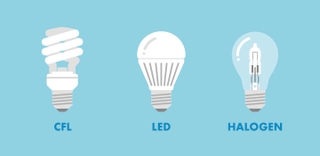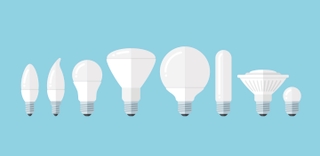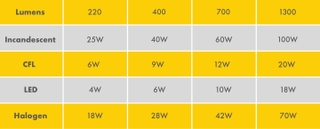Shining a light on energy saving bulbs
17 September 2019

On the last Sunday in October, the clocks will go back one hour at 2am. And as usual, due to the longer nights and darker mornings, we’ll need to rely more on the lighting in our home.
The lighting in your home accounts for about 15 percent of your electricity bill. If you’ve still got incandescent light bulbs, you’ll make huge cost savings by changing them for energy saving bulbs. Swapping all household light bulbs reduces the average annual electricity bill by £75.
Switching to energy saving light bulbs is a great way to save money on your energy bills. With so many different types and wattages to choose from, here we tackle the questions we’re asked most often so you can find the right bulbs for your home.
What are incandescent light bulbs?
Traditional incandescent light bulbs have been used for over a hundred years. They produce light by heating up a tungsten filament, but only five percent of the electricity used converts into visible light. The remaining 95 percent is lost as heat energy that is emitted as invisible infrared light. Because incandescent light bulbs are so inefficient, they have been phased out across Europe and many other parts of the world.
What are energy saving light bulbs?
Energy saving light bulbs use a lot less power than traditional bulbs. They use different technology to old-style bulbs which means they consume up to 90 percent less electricity. They also have a much longer lifespan. This quickly adds up when you change a few more.
Types of energy saving light bulbs and how they work

There are three different types of energy saving light bulb to choose from:
CFL, or compact fluorescent lamp
CFL bulbs use 60 to 80 percent less electricity than incandescent light bulbs. CFLs are the most common type of energy saving bulb and they come in a wide range of sizes and styles. Easily recognisable by their glass tube design, they work by causing an inner phosphorous coating to glow. CFLs have a lifespan of about 10 years and prices start from £2 per bulb.
Halogen
Halogen bulbs use 20 to 30 percent less electricity than incandescent light bulbs. Similar to traditional bulbs, halogens have a tungsten filament. However, because the filament is surrounded by halogen gas, it burns hotter with less electricity. The lifespan of halogen bulbs is about two years and they are the cheapest, starting at £1 a bulb.
LED, or light-emitting diode
LED bulbs use 90 percent less electricity than incandescent light bulbs. Individual LEDs are very small so LED bulbs have lots of LEDs in order to produce an acceptable level of light. Unlike other types of light bulb, LED bulbs only emit light in one direction. This makes them ideal as spotlights. LED bulbs last around 25 years and prices vary, ranging between £3 and £20 per bulb.
What bulb fittings do I need?
Energy saving light bulbs are available with the same fittings as traditional bulbs. Check the existing bulb or light fixture to find out what bulb fitting it is. The most common bulb fittings are B22 bayonet cap, E27 screw cap and GU10.
Will using energy saving light bulbs save me money?
Using energy saving bulbs instead of traditional bulbs will considerably reduce your electricity bill. Swapping one incandescent bulb for an energy saving bulb will save you between £7 and £7.50 a year. By changing to energy saving light bulbs throughout your home, you’ll save around £75 annually.
To save another £25 to £55 on your annual energy bill, you could make your own draught excluder.
Can you replace halogen light bulbs with LED light bulbs?
You can replace your halogen lights with LED lights, although if there is a transformer in the ceiling or within the light fixture, it may be too overpowered for LED bulbs. In this case, there are two options. You can buy special LED bulbs with individual circuitry that cope with all types of transformer. Alternatively, you can replace your transformer with an LED driver.
Can you get dimmable energy saving light bulbs?
Most energy saving bulbs are dimmable, and this should be stated on the box. If you have an older dimmer switch, you may need to get a new one. This is because older dimmer switches are not designed for such a low draw of power that modern bulbs have.
What shape light bulb should I buy?

If you stick to the same shape of bulb as before, you know it’ll definitely work with the fixture. The most common bulb shapes are traditional, candle, spiral, stick and spotlight. If you fancy trying a different shape, check the dimensions of the existing bulb so your new bulb fits.
Energy saving bulbs wattage
Energy saving bulbs use much less electricity than traditional bulbs, so the wattage is different. Check out our handy table to find out which wattage light bulb to use:

How bright should my lights be?
Check existing bulbs or light fixtures for bulb wattage to find out how bright they are. The brightness of a light bulb is given in lumens. To get an idea of how bright a bulb is, an incandescent 60W bulb has a brightness of approximately 700 lumens. This is about right for living rooms, but you may prefer more lumens for work areas and less for small rooms or spotlights.
Have a look at the above table to compare the energy saving light bulbs equivalent wattage.
Are all energy saving light bulbs slow when you first turn them on?
With CFL bulbs, there is a slight delay from when you hit the switch to when the light comes on. This is simply the nature of fluorescent lights. LED bulbs and halogen bulbs both provide instant light.
Switching to energy saving light bulbs
By switching to energy saving light bulbs, there are impressive savings of up to £75 a year to be made. Ditching your old incandescent bulbs in favour of CFLs, LEDs or halogens is a great move. Even switching between different types of energy saving bulb will save you money, and you can often use your existing bulb fittings to do so.
There are more ways to save energy
With the wide variety of energy saving light bulbs that are available, we hope you’ve found at least one type that could work for you in your household. But switching your light bulbs is just one way you could save energy. Take a look at our other energy saving tips to see how you can make small tweaks in the home and save money in the process.